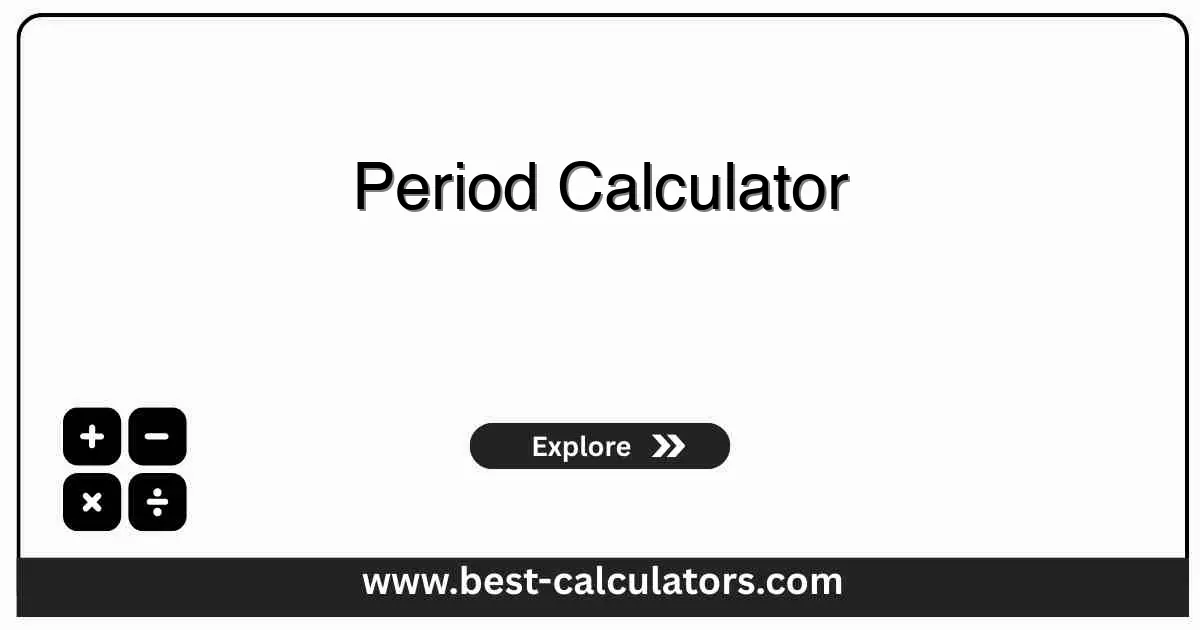Period Calculator - Calculate Next Period & Ovulation
Calculate your next period date, ovulation window, and fertile days based on menstrual cycle length for accurate cycle tracking
Period Calculator
Your Cycle Predictions
Upcoming Cycles
| Cycle | Period Starts | Period Ends | Ovulation | Fertile Window |
|---|
What is a Period Calculator?
A Period Calculator is a free women's health tool that predicts your next menstrual period date, ovulation day, and fertile window based on your cycle length and last period date. It helps you track your menstrual cycle, plan for pregnancy, or avoid conception naturally.
This calculator helps you:
- Predict next period - Know when to expect your next menstrual cycle
- Track ovulation - Identify your most fertile days for conception
- Plan ahead - Schedule activities around your cycle
- Monitor health - Track cycle regularity and patterns
If you're pregnant and want to track exactly how far along you are, use our Gestational Age Calculator to determine your precise gestational age in weeks and days for monitoring pregnancy progress.
To calculate your pregnancy due date based on your last menstrual period, check out our Pregnancy Due Date Calculator to determine your estimated delivery date and track important pregnancy milestones.
For understanding your overall health and weight status during your cycle, explore our BMI Calculator to calculate your body mass index and assess if hormonal changes are affecting your weight.
To optimize your nutrition during different phases of your menstrual cycle, use our Macronutrient Calculator to balance protein, carbs, and fats for hormonal health and energy levels.
For calculating your daily calorie needs which fluctuate during your cycle, try our TDEE Calculator to determine total daily energy expenditure and adjust nutrition accordingly.
How the Period Calculator Works
The calculator uses menstrual cycle science to predict dates:
Menstrual Cycle Phases:
- Menstrual Phase (Days 1-5): Period bleeding, hormone levels low
- Follicular Phase (Days 1-13): Egg matures, estrogen rises
- Ovulation (Day 14): Egg released, most fertile 24 hours
- Luteal Phase (Days 15-28): Progesterone rises, prepares for pregnancy
Calculation Accuracy:
- Regular cycles (28-32 days): 80-90% accurate
- Irregular cycles: 60-70% accurate, track 3-6 months
- Ovulation timing: Typically 14 days before next period
Understanding Your Menstrual Cycle
Cycle Length
Normal cycles range from 21-35 days. Count from the first day of bleeding to the day before your next period starts.
Ovulation Window
Ovulation occurs 12-16 days before your next period. The egg survives 12-24 hours after release.
Fertile Days
The 5 days before ovulation plus ovulation day. Sperm can survive up to 5 days waiting for the egg.
Period Duration
Normal bleeding lasts 2-7 days, with 3-5 days being most common. Heavy flow typically occurs on days 1-2.
How to Use This Calculator
Enter Last Period Date
Select the first day of your last menstrual period
Set Cycle Length
Enter your average cycle length (21-45 days)
Enter Period Duration
How many days your period typically lasts (2-10 days)
View Predictions
See next period, ovulation, and fertile window dates
Benefits of Using This Calculator
- • Pregnancy Planning: Identify your most fertile days to maximize conception chances or avoid pregnancy naturally.
- • Cycle Tracking: Monitor menstrual regularity and detect potential health issues early through pattern recognition.
- • Better Planning: Schedule vacations, events, and activities around your cycle to avoid period inconvenience.
- • Health Awareness: Understand your body's natural rhythms and hormonal changes throughout the month.
- • Symptom Management: Anticipate PMS symptoms, mood changes, and energy fluctuations to prepare accordingly.
Factors That Affect Your Cycle
1. Stress & Lifestyle
High stress, poor sleep, excessive exercise, or sudden weight changes can delay ovulation and lengthen or shorten your cycle.
2. Hormonal Changes
Birth control, breastfeeding, perimenopause, PCOS, or thyroid disorders significantly affect cycle regularity and ovulation timing.
3. Age & Life Stage
Teenagers and women approaching menopause often have irregular cycles. Peak fertility and regularity occur in your 20s-early 30s.
4. Health Conditions
Endometriosis, fibroids, diabetes, or chronic illnesses can cause irregular periods, heavy bleeding, or unpredictable ovulation.

Frequently Asked Questions (FAQ)
Q: How accurate is a period calculator?
A: Period calculators are 80-90% accurate for women with regular cycles (28-32 days). Accuracy decreases with irregular cycles, stress, hormonal changes, or health conditions. Track 3-6 cycles for better predictions.
Q: What is a normal menstrual cycle length?
A: A normal menstrual cycle ranges from 21-35 days, with 28 days being average. Cycle length is measured from the first day of one period to the first day of the next period.
Q: Can I get pregnant during my period?
A: While unlikely, it's possible with short cycles (21-24 days) or long periods (7+ days). Sperm can survive 5 days, so intercourse near the end of your period could result in pregnancy if you ovulate early.
Q: When is my fertile window?
A: Your fertile window is typically 5-6 days: the 5 days before ovulation plus ovulation day. Ovulation usually occurs 14 days before your next period. Sperm can survive 5 days, making this the optimal conception window.
Q: How long does ovulation last?
A: Ovulation itself lasts 12-24 hours when the egg is released. However, the fertile window extends 5-6 days because sperm can survive up to 5 days in the reproductive tract waiting for the egg.
Q: Why is my cycle irregular?
A: Irregular cycles can result from stress, weight changes, excessive exercise, PCOS, thyroid issues, perimenopause, or hormonal imbalances. Consult a healthcare provider if irregularity persists for 3+ months.